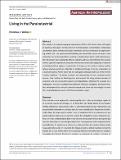| dc.contributor.author | Walley, Christine J | |
| dc.date.accessioned | 2025-10-01T16:56:09Z | |
| dc.date.available | 2025-10-01T16:56:09Z | |
| dc.date.issued | 2025-02-01 | |
| dc.identifier.uri | https://hdl.handle.net/1721.1/162856 | |
| dc.description.abstract | This article is an autoethnographic exploration of life in the former steel mill regionof Southeast Chicago in the ‘Rust Belt’ of the Midwestern United States. It challengesassumptions about deindustrialization that depict one discrete historical stage follow-ing another (i.e., the postindustrial following the industrial) in favor of what is heredefined as the ‘paraindustrial’ (or a setting in which active industry with minimal num-bers of workers exists alongside defunct industry and toxic brownfields). This accountcenters upon the experiences of women who have too often been neglected in researchon deindustrialized regions. In particular, it focuses on the author’s elderly motherArlene who has spent her entire life in Southeast Chicago. From her wheelchair ona backyard porch, Arlene observes this damaged landscape built out of the formerCalumet wetlands. The article considers the relationships of care, centered aroundwomen, that continue to bind together and support the living despite decades ofeconomic and environmental rupture and degradation. Utilizing the concept of a‘palimpsest,’ the piece considers how different historical, ecological, and social reali-ties and temporalities are both layered on top of each other and intermingle to createthe complex landscape found in this former wetland region. | en_US |
| dc.language.iso | en | |
| dc.publisher | Wiley | en_US |
| dc.relation.isversionof | https://doi.org/10.1111/aman.28047 | en_US |
| dc.rights | Creative Commons Attribution-NonCommercial-NoDerivatives | en_US |
| dc.rights.uri | https://creativecommons.org/licenses/by-nc-nd/4.0/ | en_US |
| dc.source | Wiley | en_US |
| dc.title | Living in the Paraindustrial | en_US |
| dc.type | Article | en_US |
| dc.identifier.citation | Walley, Christine J. 2025. “ Living in the Paraindustrial.” American Anthropologist 127: 131–139. | en_US |
| dc.contributor.department | Massachusetts Institute of Technology. Department of Anthropology | en_US |
| dc.relation.journal | American Anthropologist | en_US |
| dc.eprint.version | Final published version | en_US |
| dc.type.uri | http://purl.org/eprint/type/JournalArticle | en_US |
| eprint.status | http://purl.org/eprint/status/PeerReviewed | en_US |
| dc.date.updated | 2025-09-29T15:02:14Z | |
| dspace.orderedauthors | Walley, CJ | en_US |
| dspace.date.submission | 2025-09-29T15:02:15Z | |
| mit.journal.volume | 127 | en_US |
| mit.journal.issue | 1 | en_US |
| mit.license | PUBLISHER_CC | |
